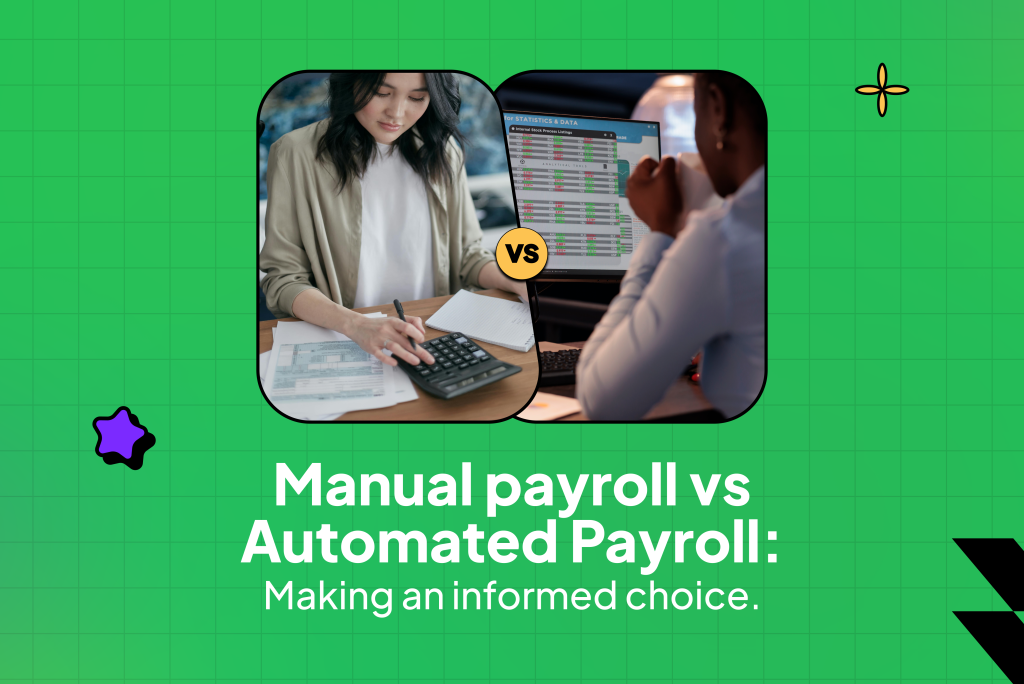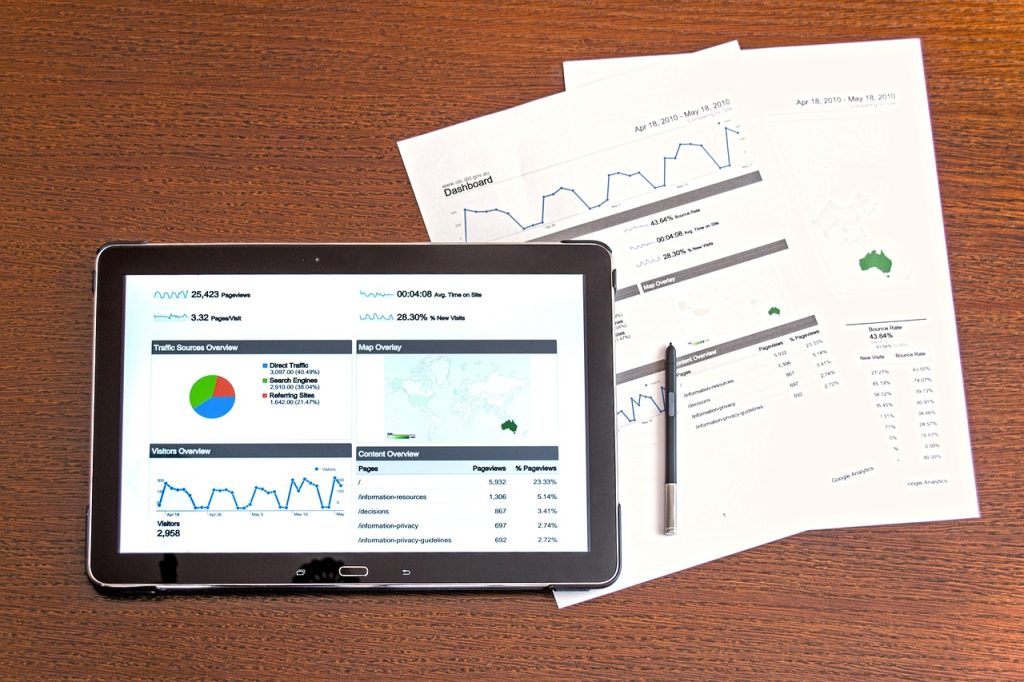
One of the most tedious but seemingly rewarding tasks we all did while growing up in school was memorizing the multiplication table. Then, as we grew older, we learned to solve complex math problems without much aid until we discovered calculators. You should already have an idea of how manual vs automated payroll works when you compare solving complex calculations alone or with the aid of a calculator.
To be honest, the difference between manual and automated payroll is much larger, and we’ll see just how much there is when we examine both payroll system options and how they affect your business choices. If you have been contemplating a payroll management system or you just need more information on which is better, stick around as we run through both payroll systems.
What is a Manual Payroll System?
A manual payroll system involves processing payroll entirely “by hand,” using spreadsheets, calculators, or basic accounting methods to calculate employee wages, deductions, taxes, and net pay. While it requires no specialized software, manual payroll is often time-intensive and error-prone.
Pros of Manual Payroll
- Low Upfront Costs
Manual payroll requires minimal financial investment, making it an attractive option for small businesses with limited budgets. There’s no need to purchase software, pay subscription fees, or invest in additional training.
- Full Control
With manual payroll, business owners or HR personnel maintain complete control over calculations, schedules, and records, which may feel reassuring for those who prefer hands-on management.
Cons of Manual Payroll
- High Risk of Errors
Human error is a significant concern. A simple mistake in a tax calculation or a missed deduction can lead to employee dissatisfaction or compliance issues. Studies show that 49% of U.S. employees would consider leaving a job after experiencing payroll errors.
- Time-Consuming
Processing payroll manually can take hours, especially for businesses with multiple employees. This time could be better spent on strategic tasks contributing to business growth.
- Complexity in Compliance
Tax laws and payroll regulations change frequently, making it difficult to stay compliant without extensive research. Manual payroll systems increase the likelihood of missteps that result in costly penalties.
- Security Risks
Sensitive employee data, such as Social Security numbers and bank account details, may be at risk if stored in unsecured files or documents.
What is an Automated Payroll System?

An automated payroll system leverages software to perform repetitive and complex payroll tasks, including calculating wages, withholding taxes, and generating pay slips. These systems are designed to streamline payroll processes while minimizing errors and compliance risks.
Pros of Automated Payroll
- Increased Efficiency
Automated systems can process payroll in a fraction of the time it takes manually. According to G2, businesses using automated payroll systems are 33% more efficient.
- Accurate Calculations
Automated payroll systems eliminate the guesswork and reduce human error. This ensures that employees are paid accurately and on time, fostering trust and satisfaction.
- Regulatory Compliance
Payroll software is often updated to reflect the latest tax laws and compliance requirements, significantly reducing the risk of non-compliance penalties.
- Enhanced Data Security
Advanced payroll systems include robust encryption and access controls, protecting sensitive employee information from breaches.
- Self-Service Features
Many automated systems offer employee portals where workers can view pay stubs, manage tax forms, and update personal information, increasing transparency and reducing the administrative burden on HR teams.
Cons of Automated Payroll
- Initial Costs
Automated systems often require upfront investment in software and training. For smaller businesses, these costs can be a barrier.
- Learning Curve
Implementing a new payroll system may require training for employees and HR personnel, which can initially slow down operations.
Manual vs Automated Payroll: A Comparison

When comparing manual and automated payroll systems, the differences become clear in certain aspects including accuracy, compliance and more. Each factor has a significant impact on how payroll systems function and their overall effectiveness for businesses.
Accuracy
Manual payroll
Manual payroll systems are highly prone to human error. Mistakes in tax calculations, deductions, or overtime pay are common and can lead to financial discrepancies, employee dissatisfaction, and even compliance issues.
Automated payroll
In contrast, automated payroll systems use algorithms to ensure precision. The software performs calculations based on pre-set rules, eliminating the risk of manual missteps. Employees are paid correctly and on time, building trust in the payroll process.
Time Efficiency
Manual payroll
Processing payroll manually can take hours—or even days—depending on the number of employees and the complexity of the calculations. For small businesses with lean teams, this time-consuming task diverts attention from strategic business activities.
Automated payroll
On the other hand, automated payroll systems handle these tasks in minutes. Automation simplifies the entire process, from calculating salaries to generating pay slips, allowing HR teams to focus on higher-value work.
Compliance
Manual payroll
Businesses constantly struggle to stay compliant with ever-changing tax laws and payroll regulations. Manual systems require significant effort to keep up with updates, increasing the risk of non-compliance penalties.
Automated payroll
Automated payroll software mitigates this risk by directly integrating the latest legal requirements and tax updates into the system. This ensures businesses remain compliant without additional research or manual adjustments, reducing stress for HR and payroll teams.
Data Security
Manual payroll
Manual payroll often relies on physical documents or unsecured spreadsheets, exposing sensitive employee data to theft, loss, or unauthorized access.
Automated payroll
Automated payroll systems provide advanced data security measures, including encryption, access controls, and cloud-based storage. These features protect sensitive information, ensuring employee trust and compliance with data protection regulations.
Costs
Manual payroll
While manual payroll may initially appear cost-effective due to the lack of software subscription fees, the hidden costs often outweigh the savings. Errors, compliance penalties, and the time spent processing payroll manually can add up, creating financial strain over time.
Automated payroll
Automated payroll systems require an upfront investment, but the long-term benefits, such as reduced errors, improved efficiency, and compliance, translate into significant cost savings for businesses.
Why Do People Still Use Manual Payroll?

Despite its drawbacks, some businesses continue to rely on manual payroll systems due to:
- Cost Concerns
Businesses operating on tight budgets may view manual payroll as the only feasible option due to its minimal upfront costs. - Familiarity
Long-standing businesses with established manual processes may resist change due to comfort with their current system. - Small Workforce
Companies with only a handful of employees may feel that manual payroll is sufficient for their needs.
The Rise of Automated Systems
The adoption of automated payroll systems is steadily growing, particularly as businesses recognize the importance of efficiency and accuracy in payroll management. Automation enables companies to scale their operations without a proportional increase in administrative work. Additionally, the rise of cloud-based payroll systems has made automation more accessible, allowing businesses of all sizes to reap the benefits of streamlined processes.
Manual vs Automated Payroll: When Should You Switch?
If you’re considering transitioning to an automated payroll system, here are some key indicators that it’s time to make the switch:
- Frequent Payroll Errors
If your business regularly encounters mistakes in tax withholdings, deductions, or paychecks, automation can eliminate these issues. - Growing Employee Base
As your workforce expands, manual payroll becomes increasingly cumbersome and error-prone. Automation ensures scalability without additional workload. - Compliance Challenges
If keeping up with changing tax laws and regulations feels overwhelming, an automated system can handle compliance seamlessly. - High Administrative Costs
While manual payroll may seem cost-effective initially, the hours spent on processing and correcting errors can add up. Automation provides long-term savings. - Employee Dissatisfaction
Delayed or inaccurate payments can harm employee morale. Automated payroll ensures consistency, fostering a more satisfied workforce.
Conclusion
Choosing between manual and automated payroll systems is more than a matter of preference, it’s a strategic decision that impacts efficiency, compliance, and employee satisfaction. While manual payroll may work for small businesses with minimal payroll needs, its limitations make it less suitable for growing organizations.
Automated payroll systems offer a range of advantages, from reducing errors to enhancing security, making them a valuable tool for modern businesses. At Salario, we understand the challenges of payroll management, which is why we offer a robust automated payroll solution tailored to meet the needs of businesses of all sizes. Whether you’re ready to make the switch or exploring your options, our software ensures timely, accurate, and secure payroll processing.
Investing in automation isn’t just about saving time; it’s about creating a reliable, efficient process that supports your business and employees alike. Make the informed choice today and see the difference an automated payroll system can bring to your business.
